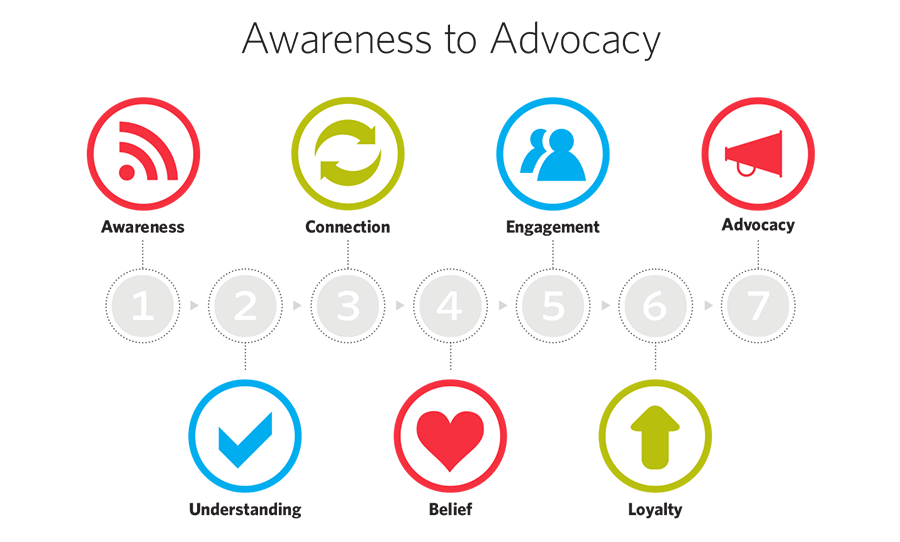Seven Stages to Brand Advocacy
While most companies want tribal brand loyalty, many are unclear about how to create raving fans that believe in and support a company’s Purpose. Creating advocacy is a journey—belief and trust can’t be built overnight.

While all companies communicate, acknowledging the stages of the communications journey and where information turns into belief and into action determines success.
1. Awareness
The sequence begins with sharing a message. Without awareness, it is invisible. This is the most familiar step and unfortunately, too many companies stop here. Once they’ve said aloud or in writing what they want people to know, they check communications off the list. Done. But not so fast! Just because the information has been exposed does not mean it connected with the intended audience.
2. Understanding
The second stage is about making sure what is shared is understood. Information can easily get lost in transit between speaker and listener or writer and reader. It is important to assure the message is clear and the communication received. Disconnects frequently happen here, and it causes frustration on both sides of the equation. Only when people fully understand what is being communicated can they progress to the next stage.
3. Connection
Once the intended audience understands the message being delivered, they begin to evaluate what was heard or read. They sift through the content to determine what it means for them. Each of us process information based on our personal experiences and needs. At this stage, message recipients decide if they want to connect, comply, or merely tune the information out.
4. Belief
At belief stage a message starts to have impact and become trusted. When people are truly accepting of the communication, they think things like, “Yes, I get it. I see the merit in this. I like this idea and believe in what I heard.” This presents an opportunity to build on the message and take it to a deeper level. When people begin believing in a message, it starts to become their truth. This is the foundation upon which strong relationships are built.
5. Engagement
Now the audience is investing time, effort, or resources into the idea. People are saying, “OK, I’ll give this a shot and see how it goes.” “I want to try this out.” They believe in what was shared and believe it might be of benefit to them. At this trial stage, the message has convinced people to act on, follow, or support the message.
6. Loyalty
This is where alignment begins to take shape. People move from trial engagement to being satisfied with the results of their efforts. They trust the message. They become willing to pay close attention to future communications. Their engagement has proved that what was shared was valuable to them. Allegiance is earned because their experience matches the message—and they are willing to stay engaged. At this stage employees resist being poached. Clients want to stay engaged. This is where the love begins.
7. Advocacy
Advocacy is the home run. When a message has been communicated, understood, evaluated, believed, acted upon, and proved valuable, people become advocates. Deep connections are formed that generally defy logic. Emotional commitments forged. And people become raving fans and brand ambassadors. They amplify a brand’s voice of and increase its impact exponentially. This stage of the sequence is the hallmark of the most admired and loved brands—those who continually bring their audiences along in concert with their purpose. Advocates start telling the brand’s story for them. They are the ones who support and defend it at all costs.
An organization’s messages must be heard, understood, and believed before they can breed the deep and enduring connections that result in tribal loyalty.
![]() With a passion for helping others discover “why” and “what for,” Jackie Dryden leads companies to uncover and align with their purpose. But don’t be fooled. Her purpose development strategy packs a punch and will shake the core of your foundation. Serving as the Chief Purpose Architect at Savage, Jackie thrives on creating design and communications strategy to support corporate purpose. She is co-author of "Get Your Head Out of Your Bottom Line and Build Your Brand on Purpose" available at https://savagethinking.com.
With a passion for helping others discover “why” and “what for,” Jackie Dryden leads companies to uncover and align with their purpose. But don’t be fooled. Her purpose development strategy packs a punch and will shake the core of your foundation. Serving as the Chief Purpose Architect at Savage, Jackie thrives on creating design and communications strategy to support corporate purpose. She is co-author of "Get Your Head Out of Your Bottom Line and Build Your Brand on Purpose" available at https://savagethinking.com.
